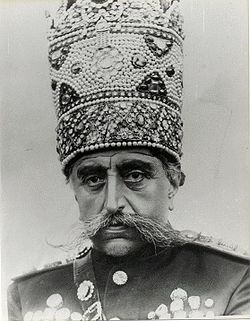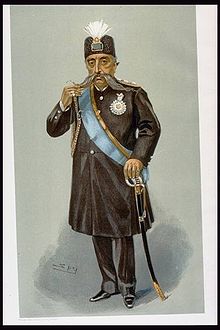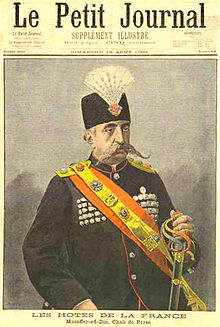- Mozaffar ad-Din Shah Qajar
-
 Mozaffar ad-Din Shah Qajar
Mozaffar ad-Din Shah QajarShahanshah of Persia 
Reign 1896-1907 Full Name Mozaffar al-Din Shah Born 23 March 1853 Birthplace Tehran, Persia Died 3 January 1907 (aged 53) Place of death Tehran, Persia Predecessor Naser al-Din Shah Qajar Successor Mohammad Ali Shah Qajar Dynasty Qajar Dynasty Religious beliefs Shia Islam Mozaffar ad-Din Shah Qajar, KG (Persian: مظفرالدين شاه قاجار, Muẓaffari’d-Dīn Shāh Qājār; 23 March 1853 – 3 January 1907) was the fifth Qajar king of Iran. He reigned between the years 1896 and 1907.
He is credited with the creation of the Iranian constitution, and often wrongly credited with the rise of the Persian Constitutional Revolution which took place immediately after his death.
Contents
Biography
The son of the Qajar ruler Naser al-Din Shah Qajar, Mozaffar ad-Din was named crown prince and sent as governor to the northern province of Azarbaijan in 1861. He spent his 35 years as crown prince in the pursuit of pleasure; his relations with his father were frequently strained, and he was not consulted in important matters of state. Thus, when he ascended the throne in May 1896, he was unprepared for the burdens of office.
At Mozaffar ad-Din's accession Iran faced a financial crisis, with annual governmental expenditures far in excess of revenues due to the policies of his father. During his reign, Mozzafar ad-Din attempted some reforms of the central treasury; however, the previous debt incurred by the Qajar court, owed to both England and Russia, significantly undermined this effort. He had to make up the existing deficit by contracting more unpopular loans from Russia, which exacted political concessions in return.
Like his father he visited Europe three times. During these periods, on the encouragements of his chancellor Amin-os-Soltan , he borrowed money from Nicholas II of Russia to pay for his extravagant traveling expenses. During his first visit he was introduced to the "cinematographe" in Paris, France. Immediately falling in love with the silver screen the Shah ordered his personal photographer to acquire all the equipment and knowledge needed to bring the moving picture to Iran, thus starting Iranian Cinema.[1] The following is a translated excerpt from the Shah's diary:
....[At] 9:00 P.M. we went to the Exposition and the Festival Hall where they were showing cinematographe, which consists of still and motion pictures. Then we went to Illusion building ....In this Hall they were showing cinematographe. They erected a very large screen in the centre of the Hall, turned off all electric lights and projected the picture of cinematography on that large screen. It was very interesting to watch. Among the pictures were Africans and Arabians traveling with camels in the African desert, which was very interesting. Other pictures were of the Exposition, the moving street, the Seine River and ships crossing the river, people swimming and playing in the water and many others that were all very interesting. We instructed Akkas Bashi to purchase all kinds of it [cinematographic equipment]and bring to Tehran so God willing he can make some there and show them to our servants.
Additionally, in order to manage the costs of the state and his extravagant personal lifestyle Mozzafar ad-din Shah was forced to sign many concessions, providing foreigners with monopolistic control of various Iranian industries and markets. One example being the D'Arcy Oil Concession.
Widespread fears amongst the aristocracy, educated elites, and religious leaders about the concessions and foreign control resulted in some protests in 1906. These resulted in the Shah accepting a suggestion to create a Majles (National Consultative Assembly) in October 1906, by which the monarch's power was curtailed as he granted a constitution and parliament to the people. He died of a heart attack 40 days after granting this constitution.
Honors
- Grand Cross of the Order of the Red Eagle of Prussia - 1893
- Grand Cross of the Order of Leopold of Austria - 1893
- The Exalted Order of Honour (Nishan-Ali-Imtiaz) of the House of Osman of Ottoman Empire - 1900
- Knight Grand Cross of the Order of the Netherlands Lion - 1900
- Knight of the Order of the Black Eagle of Prussia - 1902
- Knight of the Order of St. Andrew of Russia - 1902
- Knight of the Order of St. Alexander Nevsky of Russia - 1902
- Knight of the Order of the White Eagle of Russia - 1902
- Knight of the Order of Saint Stanislaus of Russia - 1902
- Knight of the Order of St. Anna, 1st Class in brilliants of Russia - 1902
- Knight of the Order of the Golden Fleece of Spain - 1902
- Knight of the Order of the Most Holy Annunciation of Italy - 1903
- Grand Cross of the Order of Saints Maurice and Lazarus of Italy - 1903
- Knight of the Order of the Garter (KG) - 1903
- Grand Cross of the Legion d'Honneur of France - 1903
- Grand Cordon of the Order of Leopold of Belgium - 1903
- Grand Cross of the Order of St. Stephen of Hungary - 1903
- Grand Cross of the Order of the Star of Romania - 1906
Children
Sons
- Prince Mohammad Ali Mirza E’tezad es-Saltaneh, later Mohammad Ali Shah (1872 - 1925)
- Prince Malek Mansur Mirza Shao es-Saltaneh (1880 - 1920)
- Prince Abol Fath Mirza Salar ed-Dowleh (1881 - 1961)
- Prince Abol Fazl Mirza Azd-os-Sultan (1882 - 1970)
- Prince Hussein Ali Mirza Nosrat es-Saltaneh (1884 - 1945)
- Prince Nasser al-Din Mirza Nasser es-Saltaneh (1897 - 1977)
Daughters
- Princess Fakhr es-Saltaneh (1870 - ?) married Abdol Majid Mirza Eyn-od-Dowleh
- Princess Ehteram es-Saltaneh (1871 - ?) married Morteza Gholi Khan Hedayat Sani ed-Dowleh
- Princess Ezzat ed-Dowleh (1873 - ?) married Abdol Hossein Mirza Farmanfarma
- Princess Shokuh es-Saltaneh (1880 - ?)
- Princess Shokuh ed-Dowleh (1883 - ?)
- Princess Fakhr ed-Dowleh (1883 - ?) mother of Ali Amini
- Princess Aghdas ed-Dowleh (1891 - ?)
- Princess Anvar ed-Dowleh (1896 - ?) married eghtedar es-Saltaneh son of Kamran Mirza
Historical anecdotes
The Shah visited the United Kingdom in August 1902 on the promise of receiving the Order of the Garter as it had been previously given to his father, Nasser-ed-Din Shah. King Edward VII refused to give this high honor to a non-Christian. Lord Lansdowne, the Foreign Secretary, had designs drawn up for a new version of the Order, without the Cross of St. George. The King was so enraged by the sight of the design, though, that he threw it out of his yacht's porthole. However, in 1903, the King had to back down and the Shah was appointed a member of the Order.[2]
A nephew of his wife was Mohammed Mossadeq, the Prime Minister of Iran that was overthrown by a coup d'état staged by the United Kingdom and the United States in the 1950's.
See also
- Persian Constitutional Revolution
- Fakhr ol dowleh
- Baghe Mozaffar, an Iranian TV show about a modern-day Qajar Khan
- Samad Khan Momtaz os-Saltaneh, ambassador of Persia to Paris
References
- ^ Iranian Cinema: Before the Revolution at www.horschamp.qc.ca
- ^ Philip Magnus, King Edward the Seventh (London: John Murray, 1964) pages 301-5.
- Walker, Richard (1998). Savile Row: An Illustrated History
- The translation of the travelogue in Issari's book: Cinema in Iran: 1900–1979 pages 58–59
- Iranian Cinema: Before the Revolution at www.horschamp.qc.ca Iranian Cinema: Before the Revolution by Shahin Parhami.
- Hamid Dabashi, Close Up: Iranian Cinema, Past, Present, and Future, 320 p. (Verso, London, 2001), Chapter 1. ISBN 1859843328
External links
- Some fragmentary motion pictures of Mozaffar al-Din Shah Qajar: YouTube.
- Portrait of Mozaffar al-Din Shah Qajar: [1].
- Mohammad-Reza Tahmasbpoor, History of Iranian Photography: Early Photography in Iran, Iranian Artists' site, Kargah
- History of Iranian Photography. Postcards in Qajar Period, photographs provided by Bahman Jalali, Iranian Artists' site, Kargah.
- History of Iranian Photography. Women as Photography Model: Qajar Period, photographs provided by Bahman Jalali, Iranian Artists' site, Kargah.
- Photos of qajar kings
Mozaffar ad-Din Shah QajarBorn: 1853 Died: 1907Regnal titles Preceded by
Naser al-Din Shah QajarShah of Persia
1896–1907Succeeded by
Mohammad Ali Shah QajarCategories:- Qajar dynasty
- 1853 births
- 1907 deaths
- Qajar shahs
- Monarchs of Persia
- Knights of the Order of the Most Holy Annunciation
- Order of St. Alexander Nevsky recipients
- Knights of the Garter
- Knights of the Golden Fleece
- Grand Crosses of the Order of Leopold (Austria)
- Recipients of the Order of the Black Eagle
- Recipients of the Order of Saint Stanislaus (Russian)
- Grand Crosses of the Order of the Star of Romania
- Recipients of the Order of St. Andrew
- Knights Grand Cross of the Order of the Netherlands Lion
- Recipients of the Order of the White Eagle (Russian)
- Recipients of the Order of St. Anna, 1st Class
- Knights Grand Cross of the Order of Saints Maurice and Lazarus
- Grand Croix of the Légion d'honneur
- Grand Cordons of the Order of Leopold (Belgium)
- Knights Grand Cross of the Order of Saint Stephen of Hungary
- Recipients of the Nishan-i Ali Imtiaz
Wikimedia Foundation. 2010.


